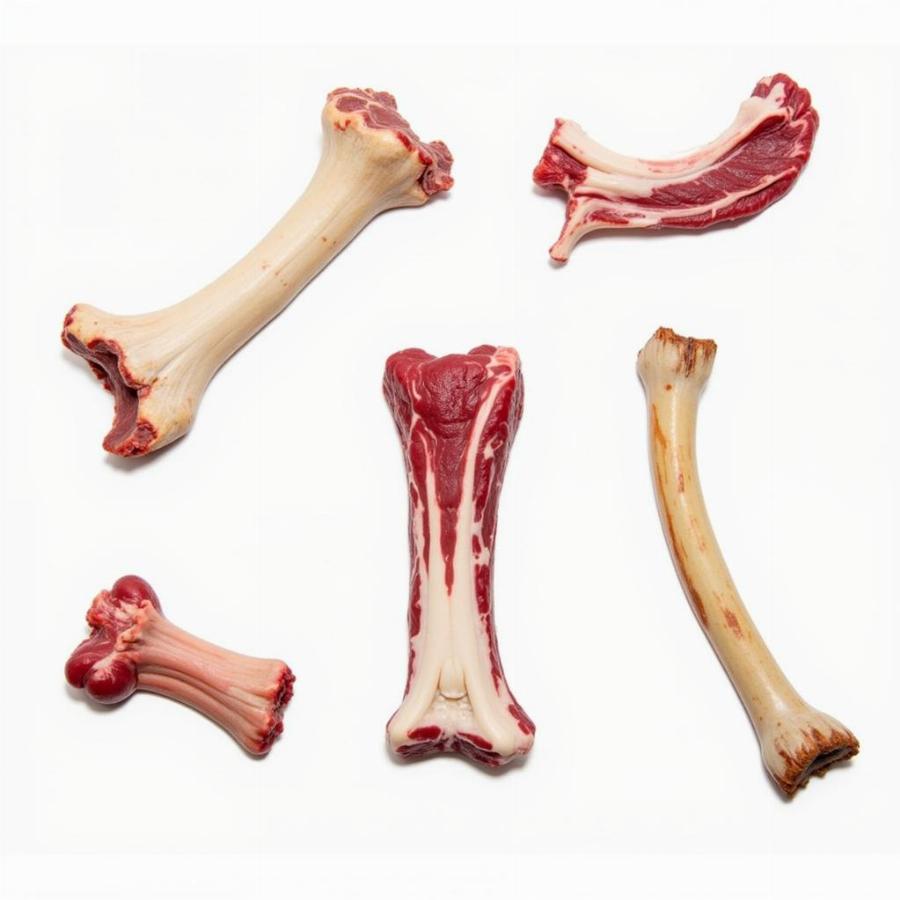Bone dog treats are a popular choice for many pet owners, offering a satisfying chew and a source of essential nutrients. But with so many options available, it’s important to understand the different types, benefits, and potential risks associated with giving your furry friend bone treats. This guide will delve into everything you need to know about bone dog treats, helping you make informed decisions to keep your canine companion happy and healthy.
Understanding the Appeal of Bone Dog Treats
Dogs have a natural instinct to chew, and bone treats can satisfy this urge while providing mental stimulation and promoting dental health. The act of gnawing on a bone can help scrape away plaque and tartar buildup, reducing the risk of gum disease and bad breath. Additionally, many bone treats are packed with nutrients like calcium and phosphorus, which contribute to strong bones and teeth. However, not all bone treats are created equal. Choosing the right type is crucial for your dog’s safety and well-being.
Types of Bone Dog Treats
There’s a wide variety of bone treats on the market, each with its own set of pros and cons. Some common types include:
- Raw Bones: These are often sourced from butchers and can include beef, lamb, or poultry bones. They provide a natural chewing experience and are rich in nutrients. However, raw bones can pose a choking hazard and may splinter, potentially causing internal injuries.
- Cooked Bones: Never give your dog cooked bones. Cooking makes bones brittle and prone to splintering, significantly increasing the risk of digestive tract damage.
- Smoked Bones: Similar to cooked bones, smoked bones are also dangerous due to their tendency to splinter. The smoking process doesn’t eliminate the risks associated with cooked bones.
- Recreational Bones: These are large, durable bones designed for long-lasting chewing enjoyment. They are typically made from nylon or other synthetic materials and are less likely to splinter than natural bones.
- Treat Bones: These are often smaller and softer than recreational bones, and can be flavored or filled with ingredients like peanut butter or cheese. They offer a tasty and satisfying chew, but should be given in moderation due to their calorie content.
 Raw Bones for Dogs: Benefits and Risks
Raw Bones for Dogs: Benefits and Risks
Choosing the Right Bone Dog Treat for Your Dog
Selecting the appropriate bone treat depends on several factors, including your dog’s size, age, chewing habits, and overall health. For aggressive chewers, durable recreational bones are a good option. Smaller dogs or those with sensitive teeth might prefer softer treat bones. Puppies should always be supervised when given any type of bone treat.
Are Bone Dog Treats Safe?
While bone treats can offer numerous benefits, they also come with potential risks. The biggest concern is splintering, which can lead to choking, intestinal blockages, or punctures. Always supervise your dog when they are chewing on a bone, and discard any bone that becomes small enough to swallow whole.
How to Give Your Dog Bone Treats Safely
- Supervision: Always supervise your dog while they are enjoying a bone treat.
- Size Matters: Choose a bone that is appropriately sized for your dog. Avoid bones that are too small, as they could be swallowed whole.
- Discard Damaged Bones: Throw away any bones that become splintered, cracked, or too small.
- Limit Chewing Time: Don’t allow your dog to chew on a bone for extended periods, as this can increase the risk of dental problems or digestive upset.
- Introduce New Treats Gradually: Start with a small amount of a new bone treat to ensure your dog tolerates it well.
What if My Dog Swallows a Bone Splinter?
If your dog swallows a bone splinter, contact your veterinarian immediately. Signs of a swallowed splinter can include vomiting, diarrhea, abdominal pain, or difficulty defecating.
Conclusion
Bone dog treats can be a valuable addition to your dog’s diet, providing mental stimulation, dental benefits, and a satisfying chew. However, it’s essential to choose the right type of bone treat and supervise your dog while they are enjoying it. By following the guidelines outlined in this article, you can help ensure that bone treats are a safe and enjoyable experience for your furry friend. Remember, if you have any concerns about giving your dog bone treats, consult with your veterinarian.
FAQ
- What are the best bone treats for aggressive chewers? Durable nylon or other synthetic recreational bones are best for aggressive chewers.
- Can puppies have bone treats? Yes, but choose soft, appropriately sized treats and always supervise them.
- Are cooked bones safe for dogs? No, cooked bones are brittle and can splinter, posing a serious risk to your dog’s health.
- How often should I give my dog a bone treat? Bone treats should be given in moderation, as part of a balanced diet.
- What should I do if my dog breaks a tooth on a bone treat? Contact your veterinarian immediately.
- Can bone treats cause constipation? Excessive bone consumption can contribute to constipation.
- Are there any alternatives to bone treats? Yes, there are numerous chew toys and dental treats available that offer similar benefits without the risks associated with bones.
Beaut Dogs is your trusted source for all things related to dog care, offering expert advice and guidance on every aspect of dog ownership. From breed selection to nutrition and training, we’re here to help you provide the best possible care for your beloved canine companion. For personalized support and answers to your specific questions, please contact us at Email: [email protected]. Beaut Dogs is committed to empowering dog owners with the knowledge and resources they need to build strong, healthy relationships with their furry friends. Visit https://beautdogs.com today to learn more!